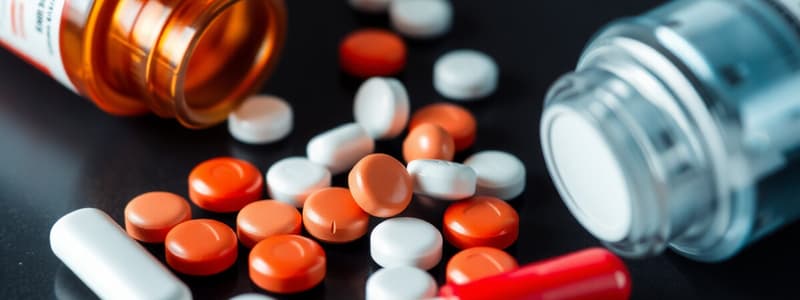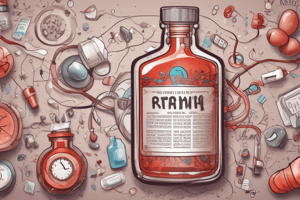Podcast
Questions and Answers
Which class of antihypertensive drugs specifically targets dihydropyridine calcium channels?
Which class of antihypertensive drugs specifically targets dihydropyridine calcium channels?
- Angiotensin Receptor Blockers
- ACE Inhibitors
- Beta-blockers
- Dihydropyridine Calcium Channel Blockers (correct)
What mechanism do thiazide diuretics primarily utilize to manage hypertension?
What mechanism do thiazide diuretics primarily utilize to manage hypertension?
- Block calcium channels in blood vessels
- Increase potassium excretion
- Inhibit angiotensin II formation
- Decrease blood volume by promoting sodium excretion (correct)
Which of the following is NOT a common side effect of angiotensin converting enzyme (ACE) inhibitors?
Which of the following is NOT a common side effect of angiotensin converting enzyme (ACE) inhibitors?
- Cough
- Hypotension
- Hypokalemia (correct)
- Angioedema
What side effect is commonly associated with the use of alpha-2 agonists like clonidine?
What side effect is commonly associated with the use of alpha-2 agonists like clonidine?
In hypertensive emergencies, which medication would be most appropriate for immediate blood pressure reduction?
In hypertensive emergencies, which medication would be most appropriate for immediate blood pressure reduction?
Which of the following medications is classified as a direct-acting vasodilator?
Which of the following medications is classified as a direct-acting vasodilator?
What is a common side effect associated with alpha-1 blockers?
What is a common side effect associated with alpha-1 blockers?
Which side effect is linked to beta-blockers due to their adverse impact on lipid metabolism?
Which side effect is linked to beta-blockers due to their adverse impact on lipid metabolism?
Which of the following is a characteristic feature of calcium channel blockers (CCBs)?
Which of the following is a characteristic feature of calcium channel blockers (CCBs)?
What is the recommended management upon abrupt withdrawal of alpha-2 receptor agonists like methyldopa?
What is the recommended management upon abrupt withdrawal of alpha-2 receptor agonists like methyldopa?
Which non-selective beta-blocker is known for its unique properties affecting both alpha and beta receptors?
Which non-selective beta-blocker is known for its unique properties affecting both alpha and beta receptors?
Which condition can be effectively managed using methyldopa during pregnancy?
Which condition can be effectively managed using methyldopa during pregnancy?
Which of the following is NOT a side effect commonly associated with beta-blockers?
Which of the following is NOT a side effect commonly associated with beta-blockers?
Which side effect is specifically associated with verapamil?
Which side effect is specifically associated with verapamil?
What is the primary mechanism of action for loop diuretics like furosemide?
What is the primary mechanism of action for loop diuretics like furosemide?
Which of the following is NOT a class of diuretics mentioned?
Which of the following is NOT a class of diuretics mentioned?
Which effect does the inhibition of ACE result in?
Which effect does the inhibition of ACE result in?
What common side effect is associated with calcium channel blockers ending with -'dipine'?
What common side effect is associated with calcium channel blockers ending with -'dipine'?
Which mechanism do potassium-sparing diuretics primarily employ?
Which mechanism do potassium-sparing diuretics primarily employ?
Which of the following ACE inhibitors is generally used to prevent vasoconstriction?
Which of the following ACE inhibitors is generally used to prevent vasoconstriction?
Which is a major concern when using diuretics that may lead to a significant electrolyte imbalance?
Which is a major concern when using diuretics that may lead to a significant electrolyte imbalance?
Flashcards
a2-agonists use
a2-agonists use
Used to treat mild-to-moderate hypertension, opiate withdrawal, and hypertensive management in pregnancy.
a1-blocker side effects
a1-blocker side effects
First-dose syncope, orthostatic hypotension; but also have a favorable effect on lipid profile.
b-blocker effect
b-blocker effect
Reduces cardiac output (CO) and renin levels; however, often have unfavorable lipid profile side effect.
b-blocker caution
b-blocker caution
Signup and view all the flashcards
BP formula
BP formula
Signup and view all the flashcards
Labetalol unique property
Labetalol unique property
Signup and view all the flashcards
Vasodilators definition
Vasodilators definition
Signup and view all the flashcards
Calcium Channel Blockers (CCBs)
Calcium Channel Blockers (CCBs)
Signup and view all the flashcards
Antihypertensive Drugs
Antihypertensive Drugs
Signup and view all the flashcards
a2-agonists
a2-agonists
Signup and view all the flashcards
Clonidine & Methyldopa
Clonidine & Methyldopa
Signup and view all the flashcards
BP = CO x TPR
BP = CO x TPR
Signup and view all the flashcards
Diuretics
Diuretics
Signup and view all the flashcards
Study Notes
Antihypertensive Drugs
- These drugs are used to treat high blood pressure (hypertension).
- Blood pressure (BP) is calculated as cardiac output (CO) multiplied by total peripheral resistance (TPR).
Antihypertensive Agents
- Drugs interfering with storage vesicles: Reserpine
- Drugs altering sympathetic activity:
- α₂ agonists: clonidine and methyldopa
- α₁ antagonists: prazosin, doxazosin, terazosin, tamsulosin
- β-blockers: metoprolol, acebutolol, atenolol
- Direct-acting vasodilators: Hydralazine, Minoxidil, Nitroprusside
- Calcium Channel Blockers:
- Dihydropyridines (DPH): Nifedipine, amlodipine
- Non-DPH: Verapamil, Diltiazem
- Diuretics: Thiazides, loop diuretics, potassium-sparing diuretics
- Angiotensin-converting enzyme inhibitors (ACEIs): captopril, enalapril, lisinopril
- Angiotensin receptor blockers (ARBs): losartan, valsartan, telmisartan
Drug Strategy for Treating Hypertension
- BP = CO x TPR
- ↓ sympathetic tone:
- ↓ TPR (α-blockers, vasodilators)
- ↓ CO (β-blockers)
- ↓ body fluid volume (diuretics)
- ↓ Angiotensin effects
- Compensatory responses to some drugs: Reflex tachycardia and Reflexive Edema
α₂-agonists
- Reduce sympathetic outflow from vasopressor centers in the brainstem.
- Clonidine, methyldopa
- α₂ receptor activation in the CNS ↓ CO and TPR by inhibiting sympathetic outflow.
α₁-blockers
- Prazosin, Doxazosin (Cardura), Terazosin, Tamsulosin.
- Relax both arterial and venous smooth muscle.
- ↓ arteriolar and venous resistance.
- Reflex tachycardia.
- Uses: Hypertension, benign prostatic hyperplasia (BPH) (Tamsulosin)
- Side effects: first-dose syncope, orthostatic hypotension
- Advantage: favorable effect on lipid profile (↓ LDL while ↑ HDL levels).
β-blockers
- Block β-adrenoceptors; ↓ CO and ↓ renin.
- Side effects: unfavorable lipid profile.
- Caution in use with non-selective β-blockers for patients with diabetes, peripheral vascular disease (Raynaud's) and asthma/COPD.
- Use ISA (pindolol or acebutolol) or cardioselective agents (acebutolol, atenolol or metoprolol) in these patients - they produce fewer respiratory and vascular effects.
Vasodilators
- Direct-acting vasodilators:
- Oral: Hydralazine (Apresoline) and Minoxidil (Loniten)
- Parenteral: Nitroprusside, Diazoxide, and Fenoldopam
- Mechanism of action: Relaxation of vascular smooth muscle and decrease of resistance (and PB).
- Calcium channel blockers (CCBs): Used for both oral and parenteral administration.
- Oral examples: Verapamil, diltiazem, nifedipine, amlodipine
- Mechanism of action: Block L-type Ca2+ channels, resulting in ↓ CO (verapamil and diltiazem) and ↓ TPR (all CCBs).
Hydralazine
- Releases nitric oxide (NO) from endothelial cells.
- ↓ TPR via arteriolar dilation.
- Use: moderate-to-severe hypertension
- Side effects: Drug-induced lupus erythematosus (DILE), edema, reflex tachycardia.
- Concomitant therapy with β-blockers, and diuretics required to counter reflex tachycardia and edema.
Minoxidil
- Uses: hypertensive emergencies (diazoxide, parenteral), severe hypertension (minoxidil), hair growth (topical).
- Side effects: hypertrichosis (minoxidil), hyperglycemia (↓ insulin release), tachycardia and edema.
Nitroprusside
- Available parenterally.
- Releases NO → dilation of arterioles and venules ↓ TPR.
- Uses: hypertensive emergencies, heart failure (HF).
- Side effects: cyanide toxicity (treat with sodium nitrite/sodium thiosulfate).
Calcium Channel Blockers (CCBs)
- Block L-type Ca2+ channels in heart and blood vessels.
- Result in ↓ intracellular Ca++
- ↓ CO (verapamil and diltiazem),↓ TPR (all CCBs).
- Drugs: Verapamil, Diltiazem, Nifedipine, and Amlodipine.
Diuretics
- Effects on kidneys to decrease sodium and water retention.
- Loop Diuretics: Furosemide, Ethacrynic acid, Bumetanide
- Mechanism: Inhibition of active salt transport
- Site of action: Thick ascending limb of the loop of Henle
- Thiazides: Hydrochlorothiazide, Chlorthalidone, Indapamide
- Mechanism: Inhibition of NaCl reabsorption
- Site of action: Early distal tubule
- Potassium-sparing diuretics: Spironolactone, Amiloride, Triamterene
- Mechanism: Late distal tubule and cortical collecting duct. competitive antagonism of aldosterone or by direct action
Angiotensin-Converting Enzyme Inhibitors (ACEIs)
- Block the formation of angiotensin II → ↓ vasoconstriction and ↓ aldosterone release to prevent fluid retention.
- Bradykinin is a potent vasodilator. ACEIs prevent bradykinin degradation, potentiating the vasodilatory properties.
- Drugs: Captopril, Enalapril, Lisinopril.
Angiotensin Receptor Blockers (ARBs)
- Block AT1 receptors.
- ARBs do not interfere with bradykinin degradation, unlike the ACEIs , and do not induce a dry cough.
- Drugs: Losartan, Valsartan, Telmisartan.
Angiotensin-Converting Enzyme Inhibitors (ACEIs) and Angiotensin Receptor Blockers (ARBS) - Clinical Uses
- Mild-to-moderate hypertension
- CHF
- Protective of diabetic nephropathy
Side effects of ACEIs and ARBS
- ACEIs: Dry cough
- Both: : Hyperkalemia, Contraindicated in bilateral renal artery stenosis, pregnancy
Studying That Suits You
Use AI to generate personalized quizzes and flashcards to suit your learning preferences.




